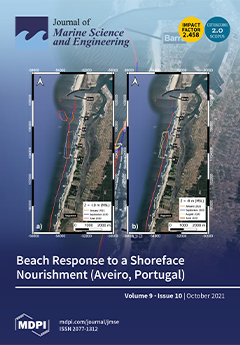Isotope measurements were performed on dissolved nitrate (NO
3−) and ammonium (NH
4+) in the coastal waters of the northeastern Beibu Gulf, China, to investigate the seasonal nitrate sources and their biogeochemical processes, which are due to the rapid
[...] Read more.
Isotope measurements were performed on dissolved nitrate (NO
3−) and ammonium (NH
4+) in the coastal waters of the northeastern Beibu Gulf, China, to investigate the seasonal nitrate sources and their biogeochemical processes, which are due to the rapid development of local industrialisation and urbanisation. The high N/P ratio observed in the coastal bay during both fall and spring suggests that P is a limiting nutrient, which in turn indicates that increasing P causes conditions favourable for algal blooms. Higher nutrient concentrations and δ
15N-NO
3− and δ
15N-NH
4+ values were found in the nearshore area in the fall, suggesting that nutrients originated mainly from land-based pollution. A Bayesian isotope mixing model was used to calculate the contribution of potential NO
3− sources and the results showed that in the nearshore area, NO
3− originated mainly from manure and sewage (58%). In the spring, however, in addition to the impact of urban sewage effluents, the exchange of sediment and water was another important factor causing higher nutrient concentrations and positive NO
3− isotopes in the nearshore area. There were lower concentrations of nutrients and an increase in δ
15N-NO
3− and δ
15N-NH
4+ values in the offshore area in the fall, and the NO
3− loss in the surface water was mainly caused by the process of assimilation. However, the exchange of sediment and water was the dominant factor causing higher nutrient concentrations (except for NO
3−) and positive dual nitrate isotopes but lower NO
3− concentration in the offshore area during the spring. Overall, isotope analysis of NO
3− and NH
4+ helps to illustrate the major sources of the former and their biological transformation in the northeastern Beibu Gulf.
Full article





